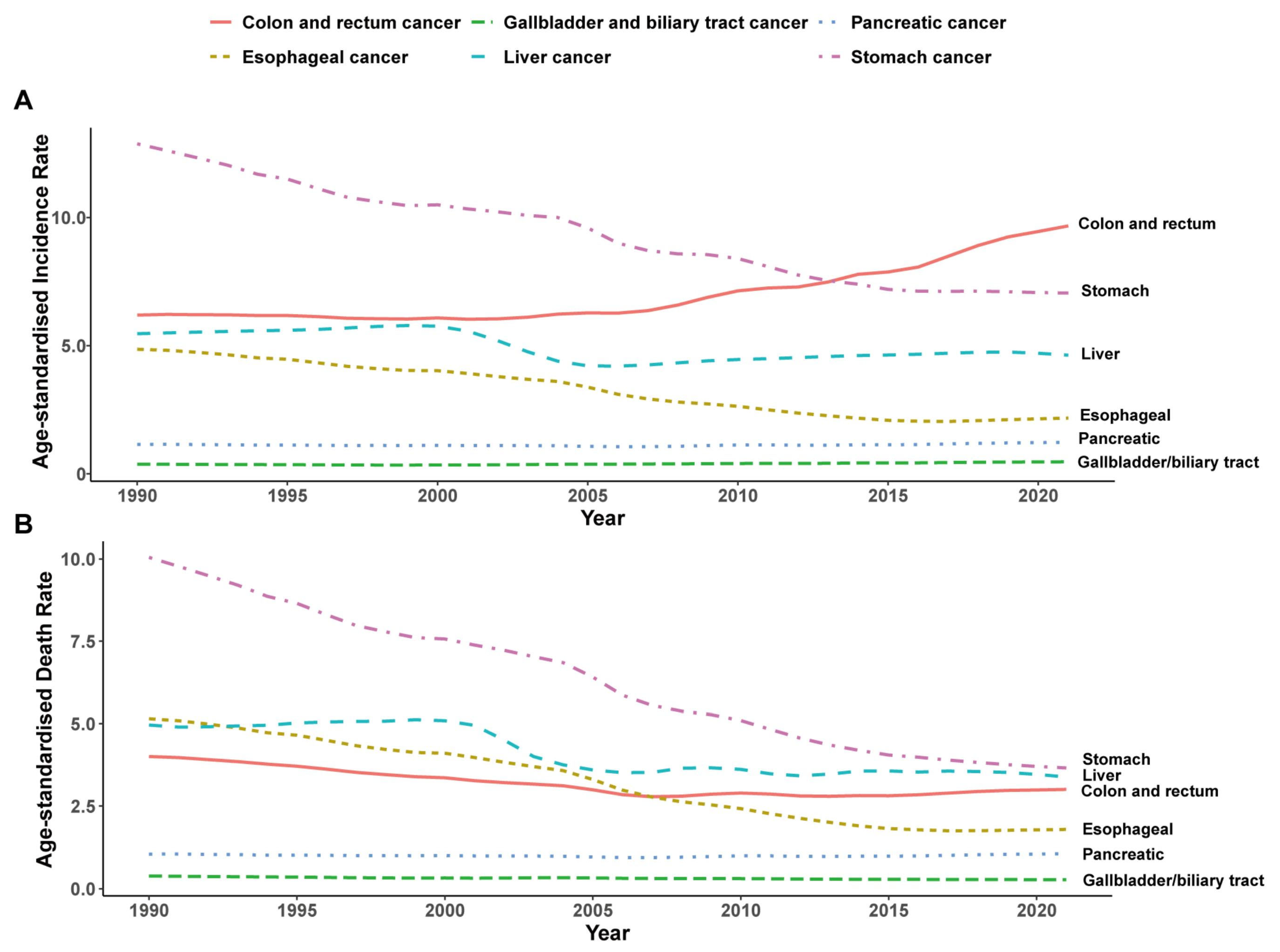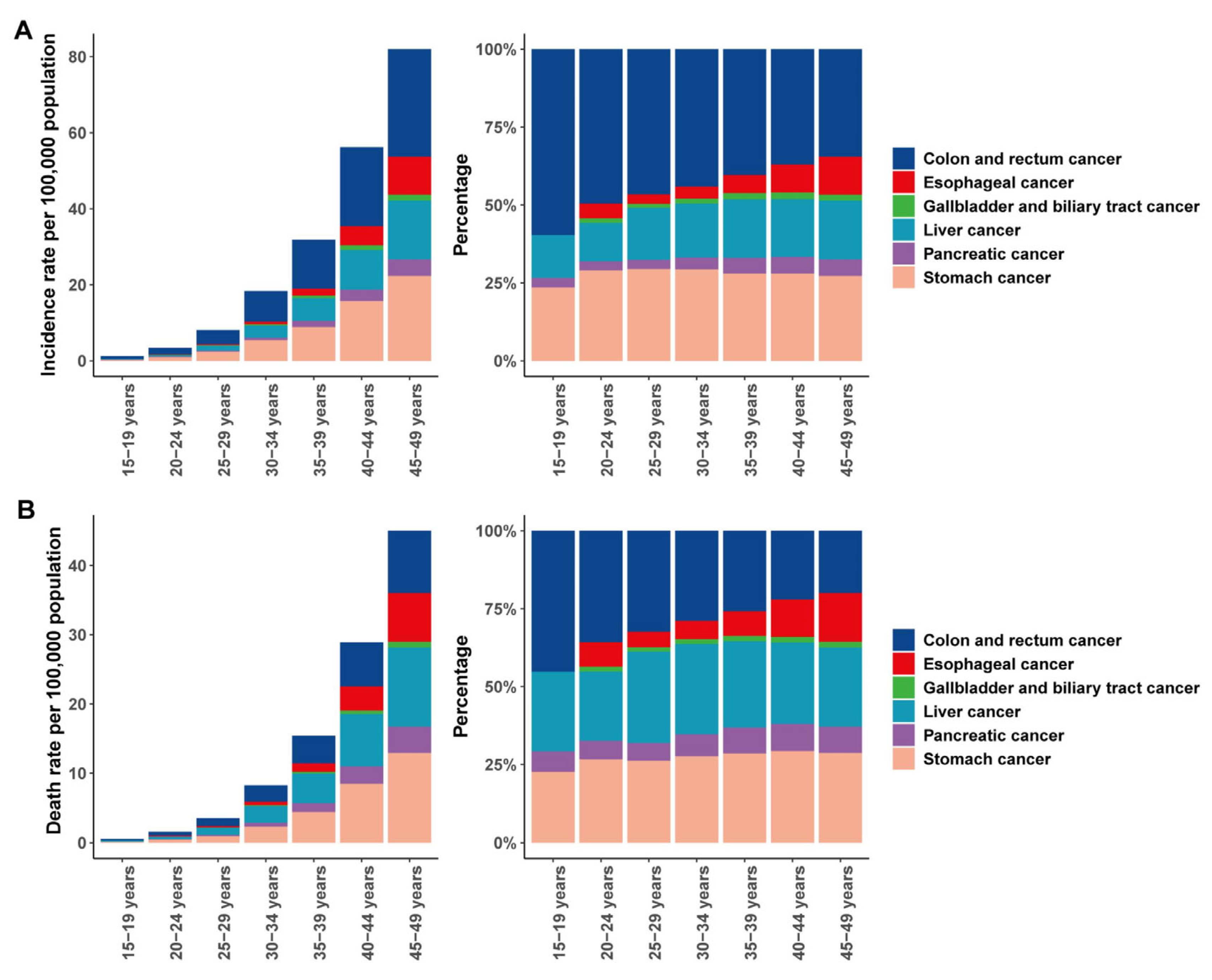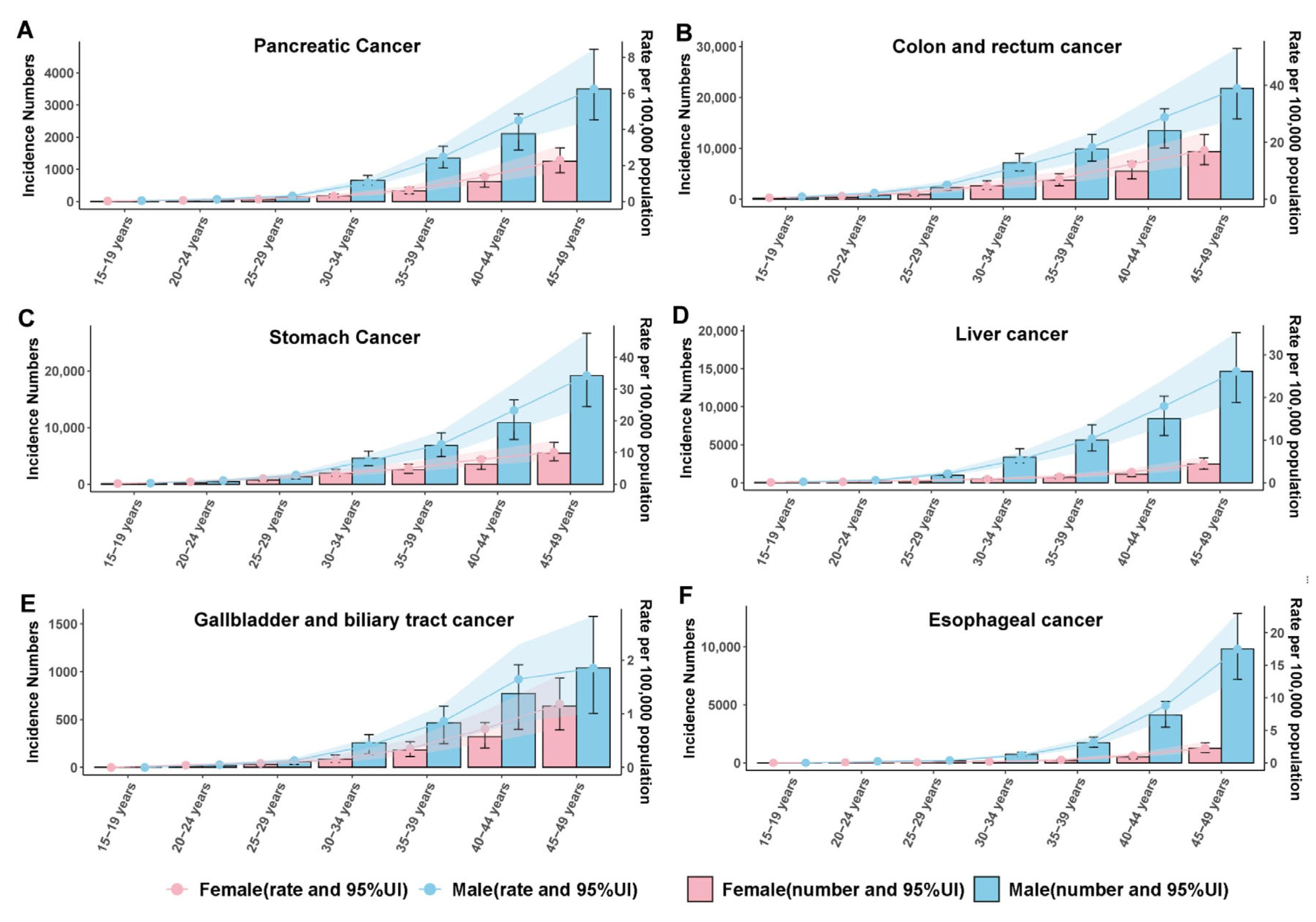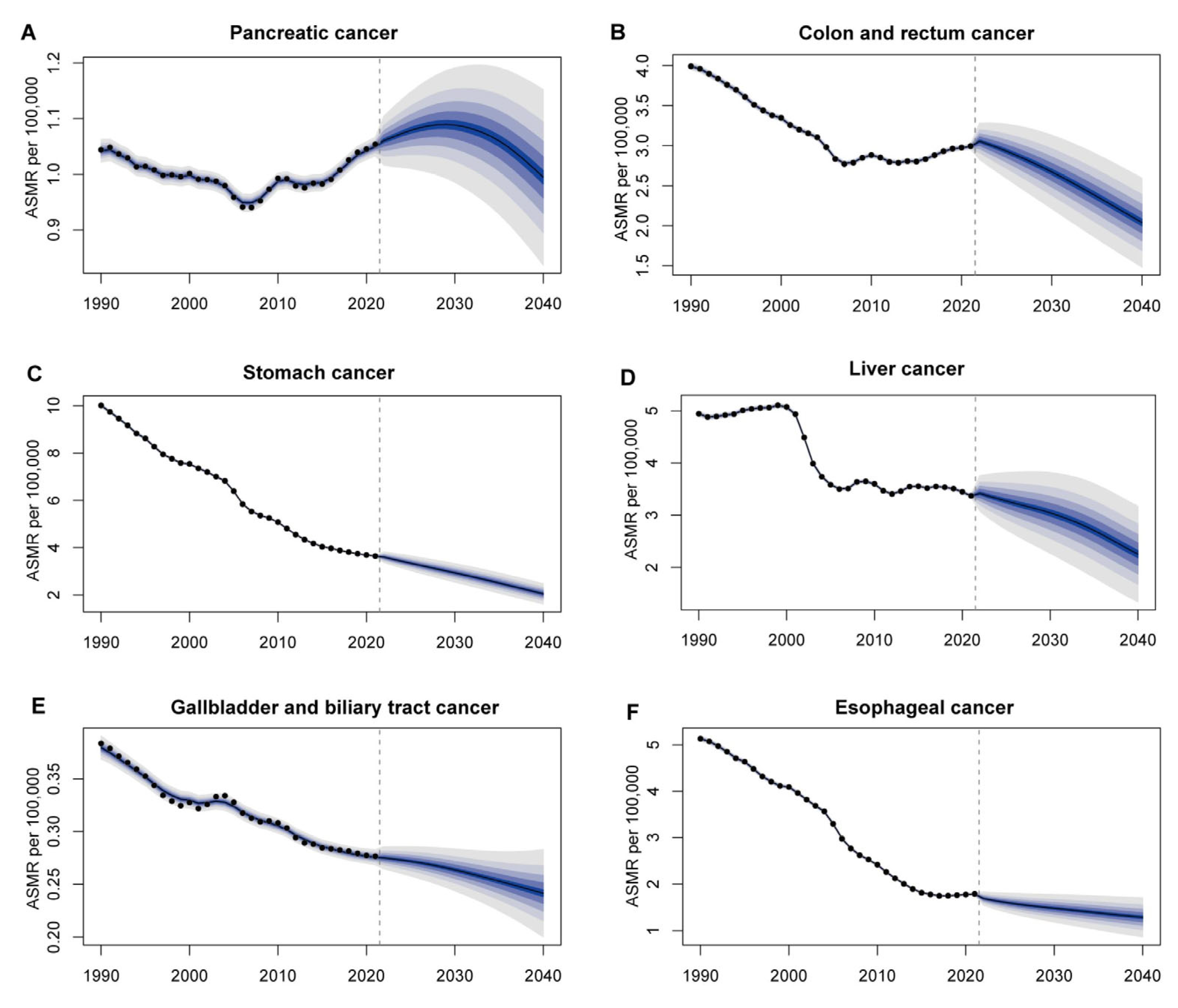Nationwide Trends and Projections of Early Onset Gastrointestinal Cancers in China
Simple Summary
Abstract
1. Introduction
2. Method
2.1. Overview and Data Collection
2.2. Temporal Trend Analysis and EAPC Calculation
2.3. AAPC Calculation
2.4. Age-Adjusted Rates Calculation
2.5. Bayesian Age–Period–Cohort Projection Model
2.6. Case Definitions
2.7. Statistical Analysis
3. Result
3.1. National Trends in Early-Onset Gastrointestinal Cancer Incidence and Mortality in China, 1990–2021
3.2. Subtype Distribution of Early-Onset Gastrointestinal Cancer Age Groups
3.3. Age- and Sex-Specific Trends in Early-Onset Gastrointestinal Cancer Incidence and Mortality
3.4. Projected Trends in Early-Onset Gastrointestinal Cancer Incidence and Mortality
4. Discussion
5. Conclusions
Supplementary Materials
Author Contributions
Funding
Institutional Review Board Statement
Informed Consent Statement
Data Availability Statement
Conflicts of Interest
Abbreviations
| ASIR | Age-Standardized Incidence Rate |
| ASMR | Age-Standardized Mortality Rate |
| EAPC | Estimated Annual Percent Change |
| AAPC | Average Annual Percent Change |
| BAPC | Bayesian Age–Period–Cohort |
| GBD | Global Burden of Disease |
| GI | Gastrointestinal |
| IHME | Institute for Health Metrics and Evaluation |
| ICD-10 | International Classification of Diseases, 10th Revision |
| UI | Uncertainty Interval |
References
- Wang, S.; Zheng, R.; Li, J.; Zeng, H.; Li, L.; Chen, R.; Sun, K.; Han, B.; Bray, F.; Wei, W.; et al. Global, regional, and national lifetime risks of developing and dying from gastrointestinal cancers in 185 countries: A population-based systematic analysis of GLOBOCAN. Lancet Gastroenterol. Hepatol. 2024, 9, 229–237. [Google Scholar] [CrossRef] [PubMed]
- Patel, S.G.; Karlitz, J.J.; Yen, T.; Lieu, C.H.; Boland, C.R. The rising tide of early-onset colorectal cancer: A comprehensive review of epidemiology, clinical features, biology, risk factors, prevention, and early detection. Lancet Gastroenterol. Hepatol. 2022, 7, 262–274. [Google Scholar] [CrossRef] [PubMed]
- Li, Z.; Zhang, X.; Sun, C.; Li, Z.; Fei, H.; Zhao, D. Global, regional, and national burdens of early onset pancreatic cancer in adolescents and adults aged 15–49 years from 1990 to 2019 based on the Global Burden of Disease Study 2019: A cross-sectional study. Int. J. Surg. 2024, 110, 1929–1940. [Google Scholar] [CrossRef] [PubMed]
- Ben-Aharon, I.; van Laarhoven, H.W.; Fontana, E.; Obermannova, R.; Nilsson, M.; Lordick, F. Early-Onset Cancer in the Gastrointestinal Tract Is on the Rise—Evidence and Implications. Cancer Discov. 2023, 13, 538–551. [Google Scholar] [CrossRef]
- Cao, W.; Chen, H.-D.; Yu, Y.-W.; Li, N.; Chen, W.-Q. Changing profiles of cancer burden worldwide and in China: A secondary analysis of the global cancer statistics 2020. Chin. Med. J. 2021, 134, 783–791. [Google Scholar] [CrossRef]
- Weinberg, B.A.; Murphy, C.C.; Freyer, D.R.; Greathouse, K.L.; Blancato, J.K.; Stoffel, E.M.; Drewes, J.L.; Blaes, A.; Salsman, J.M.; You, Y.N.; et al. Rethinking the rise of early-onset gastrointestinal cancers: A call to action. JNCI Cancer Spectr. 2025, 9, pkaf002. [Google Scholar] [CrossRef]
- Collaborators GDaI. Global incidence, prevalence, years lived with disability (YLDs), disability-adjusted life-years (DALYs), and healthy life expectancy (HALE) for 371 diseases and injuries in 204 countries and territories and 811 subnational locations, 1990–2021: A systematic analysis for the Global Burden of Disease Study 2021. Lancet 2024, 403, 2133–2161. [Google Scholar]
- Li, T.; Cao, Z.; Lin, C.; Wang, W. Global Burden of Thyroid Cancer in Children and Adolescents, 1990–2021: Trends, Disparities, and Future Projections. Cancers 2025, 17, 892. [Google Scholar] [CrossRef]
- Clegg, L.X.; Hankey, B.F.; Tiwari, R.; Feuer, E.J.; Edwards, B.K. Estimating average annual per cent change in trend analysis. Stat. Med. 2009, 28, 3670–3682. [Google Scholar] [CrossRef]
- Liu, Z.; Xu, K.; Jiang, Y.; Cai, N.; Fan, J.; Mao, X.; Suo, C.; Jin, L.; Zhang, T.; Chen, X. Global trend of aetiology-based primary liver cancer incidence from 1990 to 2030: A modelling study. Int. J. Epidemiol. 2020, 50, 128–142. [Google Scholar] [CrossRef]
- Riebler, A.; Held, L. Projecting the future burden of cancer: Bayesian age-period-cohort analysis with integrated nested Laplace approximations. Biom. J. 2017, 59, 531–549. [Google Scholar] [CrossRef] [PubMed]
- Jakszyn, P.; Gonzalez, C.-A. Nitrosamine and related food intake and gastric and oesophageal cancer risk: A systematic review of the epidemiological evidence. World J. Gastroenterol. 2006, 12, 4296–4303. [Google Scholar] [CrossRef] [PubMed]
- Palladino-Davis, A.G.; Mendez, B.M.; Fisichella, P.M.; Davis, C.S. Dietary habits and esophageal cancer. Dis. Esophagus 2013, 28, 59–67. [Google Scholar] [CrossRef]
- Duan, Y.; Xu, Y.; Dou, Y.; Xu, D. Helicobacter pylori and gastric cancer: Mechanisms and new perspectives. J. Hematol. Oncol. 2025, 18, 10. [Google Scholar] [CrossRef] [PubMed]
- Watari, J.; Chen, N.; Amenta, P.S.; Fukui, H.; Oshima, T.; Tomita, T.; Miwa, H.; Lim, K.-J.; Das, K.M. Helicobacter pylori associated chronic gastritis, clinical syndromes, precancerous lesions, and pathogenesis of gastric cancer development. World J. Gastroenterol. 2014, 20, 5461–5473. [Google Scholar] [CrossRef]
- Shah, S.C.; Wang, A.Y.; Wallace, M.B.; Hwang, J.H. AGA Clinical Practice Update on Screening and Surveillance in Individuals at Increased Risk for Gastric Cancer in the United States: Expert Review. Gastroenterology 2024, 168, 405–416. [Google Scholar] [CrossRef]
- McGlynn, K.A.; Petrick, J.L.; El-Serag, H.B. Epidemiology of Hepatocellular Carcinoma. Hepatology 2021, 73 (Suppl. 1), 4–13. [Google Scholar] [CrossRef]
- Hsu, Y.-C.; Huang, D.Q.; Nguyen, M.H. Global burden of hepatitis B virus: Current status, missed opportunities and a call for action. Nat. Rev. Gastroenterol. Hepatol. 2023, 20, 524–537. [Google Scholar] [CrossRef]
- Sankar, K.; Gong, J.; Osipov, A.; Miles, S.A.; Kosari, K.; Nissen, N.N.; Hendifar, A.E.; Koltsova, E.K.; Yang, J.D. Recent advances in the management of hepatocellular carcinoma. Clin. Mol. Hepatol. 2023, 30, 1–15. [Google Scholar] [CrossRef]
- Spaander, M.C.W.; Zauber, A.G.; Syngal, S.; Blaser, M.J.; Sung, J.J.; You, Y.N.; Kuipers, E.J. Young-onset colorectal cancer. Nat. Rev. Dis. Primers 2023, 9, 21. [Google Scholar] [CrossRef]
- Li, J.; Chen, Z.; Wang, Q.; Du, L.; Yang, Y.; Guo, F.; Li, X.; Chao, Y.; Ma, Y. Microbial and metabolic profiles unveil mutualistic microbe-microbe interaction in obesity-related colorectal cancer. Cell Rep. Med. 2024, 5, 101429. [Google Scholar] [CrossRef]
- Pearlman, R.; Frankel, W.L.; Swanson, B.; Zhao, W.; Yilmaz, A.; Miller, K.; Bacher, J.; Bigley, C.; Nelsen, L.; Goodfellow, P.J.; et al. Prevalence and Spectrum of Germline Cancer Susceptibility Gene Mutations Among Patients with Early-Onset Colorectal Cancer. JAMA Oncol. 2017, 3, 464–471. [Google Scholar] [CrossRef]
- Li, Y.; Zhang, J.; Ma, H. Chronic inflammation and gallbladder cancer. Cancer Lett. 2014, 345, 242–248. [Google Scholar] [CrossRef]
- Roa, J.C.; García, P.; Kapoor, V.K.; Maithel, S.K.; Javle, M.; Koshiol, J. Gallbladder cancer. Nat. Rev. Dis. Primers 2022, 8, 69. [Google Scholar] [CrossRef] [PubMed]
- Lei, S.; Huang, G.; Li, X.; Xi, P.; Yao, Z.; Lin, X. Global Burden, Trends, and Inequalities of Gallbladder and Biliary Tract Cancer, 1990–2021: A Decomposition and Age-Period-Cohort Analysis. Liver Int. 2025, 45, e16199. [Google Scholar] [CrossRef] [PubMed]
- Song, M.; Garrett, W.S.; Chan, A.T. Nutrients, Foods, and Colorectal Cancer Prevention. Gastroenterology 2015, 148, 1244–1260. [Google Scholar] [CrossRef] [PubMed]
- Isaksen, I.M.; Dankel, S.N. Ultra-processed food consumption and cancer risk: A systematic review and meta-analysis. Clin. Nutr. 2023, 42, 919–928. [Google Scholar] [CrossRef]
- Kong, C.; Liang, L.; Liu, G.; Du, L.; Yang, Y.; Liu, J.; Shi, D.; Li, X.; Ma, Y. Integrated metagenomic and metabolomic analysis reveals distinct gut-microbiome-derived phenotypes in early-onset colorectal cancer. Gut 2022, 72, 1129–1142. [Google Scholar] [CrossRef]
- Ishiguro, S.; Inoue, M.; Kurahashi, N.; Iwasaki, M.; Sasazuki, S.; Tsugane, S. Risk factors of biliary tract cancer in a large-scale population-based cohort study in Japan (JPHC study); with special focus on cholelithiasis, body mass index, and their effect modification. Cancer Causes Control 2007, 19, 33–41. [Google Scholar] [CrossRef]
- Piovani, D.; Nikolopoulos, G.K.; Aghemo, A.; Lleo, A.; Alqahtani, S.A.; Hassan, C.; Repici, A.; Bonovas, S. Environmental Risk Factors for Gallbladder Cancer: Field-Wide Systematic Review and Meta-Analysis. Clin. Gastroenterol. Hepatol. 2024, 23, 1500–1513. [Google Scholar] [CrossRef]
- Li, T.; Lin, C.; Wang, W. Global, regional, and national burden of pancreatic cancer from 1990 to 2021, its attributable risk factors, and projections to 2050: A systematic analysis of the global burden of disease study 2021. BMC Cancer 2025, 25, 189. [Google Scholar] [CrossRef]
- Tan, Z.; Meng, Y.; Wu, Y.; Zhen, J.; He, H.; Pu, Y.; Zhang, J.; Dong, W. The burden and temporal trend of early onset pancreatic cancer based on the GBD 2021. NPJ Precis. Oncol. 2025, 9, 32. [Google Scholar] [CrossRef] [PubMed]
- Xia, C.; Basu, P.; Kramer, B.S.; Li, H.; Qu, C.; Yu, X.Q.; Canfell, K.; Qiao, Y.; Armstrong, B.K.; Chen, W. Cancer screening in China: A steep road from evidence to implementation. Lancet Public Health 2023, 8, e996-e1005. [Google Scholar] [CrossRef] [PubMed]
- Murray, K.; Oldfield, L.; Stefanova, I.; Gentiluomo, M.; Aretini, P.; O’sUllivan, R.; Greenhalf, W.; Paiella, S.; Aoki, M.N.; Pastore, A.; et al. Biomarkers, omics and artificial intelligence for early detection of pancreatic cancer. Semin. Cancer Biol. 2025, 111, 76–88. [Google Scholar] [CrossRef] [PubMed]
- Kotsiliti, E. Air pollution and oesophageal cancer risk. Nat. Rev. Gastroenterol. Hepatol. 2023, 20, 344. [Google Scholar] [CrossRef]
- Peana, M.; Pelucelli, A.; Chasapis, C.T.; Perlepes, S.P.; Bekiari, V.; Medici, S.; Zoroddu, M.A. Biological Effects of Human Exposure to Environmental Cadmium. Biomolecules 2022, 13, 36. [Google Scholar] [CrossRef]
- Sherman, M.E.; Levi, M.; Teras, L.R. Reproductive Events and Risk of Women’s Cancers: From Parturition to Prevention. Cancer Prev. Res. 2023, 16, 309–312. [Google Scholar] [CrossRef]
- Han, B.; Zheng, R.; Zeng, H.; Wang, S.; Sun, K.; Chen, R.; Li, L.; Wei, W.; He, J. Cancer incidence and mortality in China, 2022. J. Natl. Cancer Cent. 2024, 4, 47–53. [Google Scholar] [CrossRef]






| Number of Cases, 1990 | Age-Standardized Rate per 100,000 Population, 1990 | Number of Cases, 2021 | Age-Standardized Rate per 100,000 Population, 2021 | Estimated Annual Percent Change | |
|---|---|---|---|---|---|
| Esophageal cancer | 25,380.20 (21,029.05, 30,165.06) | 4.86 (3.98, 5.84) | 18,898.87 (14,639.67, 23,588.69) | 2.18 (1.69, 2.76) | −3.23 (−3.47, −2.99) |
| Stomach cancer | 70,248.17 (55,605.96, 82,397.39) | 12.87 (10.14, 15.20) | 58,119.32 (45,912.46, 74,437.82) | 7.05 (5.46, 9.01) | −2.10 (−2.21, −2.00) |
| Liver cancer | 30,185.39 (24,838.63, 36,227.37) | 5.47 (4.42, 6.67) | 38,508.72 (30,544.44, 50,232.43) | 4.63 (3.53, 6.04) | −0.84 (−1.14, −0.53) |
| Colon and rectum cancer | 35,027.26 (29,409.35, 40,729.02) | 6.19 (5.12, 7.26) | 78,692.27 (62,703.11, 96,467.59) | 9.67 (7.67, 11.95) | 1.44 (1.16, 1.73) |
| Gallbladder and biliary tract cancer | 2034.69 (1359.13, 2459.96) | 0.38 (0.25, 0.46) | 3893.24 (2417.46, 5088.76) | 0.47 (0.29, 0.62) | 0.92 (0.73, 1.11) |
| Pancreatic cancer | 6240.82 (5256.33, 7386.02) | 1.15 (0.95, 1.37) | 10,301.58 (7944.13, 12,878.47) | 1.23 (0.95, 1.55) | 0.17 (0.04, 0.30) |
| AAPC of Incidence Rate | p-Value | AAPC of Death Rate | p-Value | |
|---|---|---|---|---|
| Esophageal cancer | −0.996 (95% CI: −1.213 ~ −0.778) | <0.001 | −1.750 (95% CI: −2.000 ~ −1.500) | <0.001 |
| Stomach cancer | −0.579 (95% CI: −0.717 ~ −0.440) | <0.001 | −1.818 (95% CI: −1.983 ~ −1.653) | <0.001 |
| Liver cancer | 0.721 (95% CI: 0.489 ~ 0.954) | <0.001 | 0.060 (95% CI: −0.210 ~ 0.330) | 0.663 |
| Colon and rectum cancer | 2.770 (95% CI: 2.650 ~ 2.890) | <0.001 | 0.164 (95% CI: 0.003 ~ 0.326) | 0.046 |
| Gallbladder and biliary tract cancer | 2.163 (95% CI: 1.990 ~ 2.335) | <0.001 | 0.370 (95% CI: 0.224 ~ 0.516) | <0.001 |
| Pancreatic cancer | 1.638 (95% CI: 1.545 ~ 1.730) | <0.001 | 1.463 (95% CI: 1.367 ~ 1.560) | <0.001 |
| Number of Cases, 1990 | Age-Standardized Rate per 100,000 Population, 1990 | Number of Cases, 2021 | Age-Standardized Rate per 100,000 Population, 2021 | Estimated Annual Percent Change | |
|---|---|---|---|---|---|
| Esophageal cancer | 22,353.26 (18,486.33, 26,566.59) | 5.15 (4.23, 6.20) | 13,002.25 (10,029.61, 16,498.22) | 1.79 (1.38, 2.30) | −4.08 (−4.35, −3.81) |
| Stomach cancer | 54,445.40 (43,552.93, 63,913.66) | 10.05 (7.93, 11.88) | 30,568.44 (23,988.19, 39,506.28) | 3.66 (2.84, 4.69) | −3.50 (−3.64, −3.35) |
| Liver cancer | 27,360.02 (22,538.10, 32,769.07) | 4.96 (4.01, 6.05) | 28,127.08 (22,350.59, 36,519.34) | 3.38 (2.58, 4.42) | −1.58 (−1.89, −1.28) |
| Colon and rectum cancer | 22,619.46 (18,985.71, 26,252.24) | 4.00 (3.30, 4.69) | 24,475.98 (19,469.18, 29,983.10) | 3.00 (2.37, 3.74) | −1.13 (−1.36, −0.90) |
| Gallbladder and biliary tract cancer | 1730.99 (1159.43, 2089.77) | 0.38 (0.26, 0.47) | 1946.30 (1260.37, 2533.62) | 0.28 (0.18, 0.37) | −1.01 (−1.09, −0.92) |
| Pancreatic cancer | 5687.11 (4791.69, 6710.96) | 1.05 (0.87, 1.25) | 8887.05 (6861.73, 11,111.82) | 1.06 (0.82, 1.33) | −0.04 (−0.16, 0.08) |
Disclaimer/Publisher’s Note: The statements, opinions and data contained in all publications are solely those of the individual author(s) and contributor(s) and not of MDPI and/or the editor(s). MDPI and/or the editor(s) disclaim responsibility for any injury to people or property resulting from any ideas, methods, instructions or products referred to in the content. |
© 2025 by the authors. Licensee MDPI, Basel, Switzerland. This article is an open access article distributed under the terms and conditions of the Creative Commons Attribution (CC BY) license (https://creativecommons.org/licenses/by/4.0/).
Share and Cite
Li, T.; Lin, C.; Wang, W. Nationwide Trends and Projections of Early Onset Gastrointestinal Cancers in China. Cancers 2025, 17, 2954. https://doi.org/10.3390/cancers17182954
Li T, Lin C, Wang W. Nationwide Trends and Projections of Early Onset Gastrointestinal Cancers in China. Cancers. 2025; 17(18):2954. https://doi.org/10.3390/cancers17182954
Chicago/Turabian StyleLi, Tianyu, Chen Lin, and Weibin Wang. 2025. "Nationwide Trends and Projections of Early Onset Gastrointestinal Cancers in China" Cancers 17, no. 18: 2954. https://doi.org/10.3390/cancers17182954
APA StyleLi, T., Lin, C., & Wang, W. (2025). Nationwide Trends and Projections of Early Onset Gastrointestinal Cancers in China. Cancers, 17(18), 2954. https://doi.org/10.3390/cancers17182954





